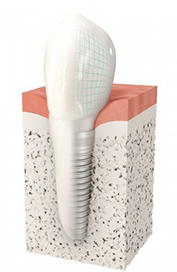Dental Implants Paris 14
The dental implantology allows for the replacement of teeth, but it is not just an aesthetic act. It also allows patients suffering from the loss of one or more teeth to regain a certain well-being.
What is a dental implant?
A dental implant is similar to an artificial root. It is most often presented as a titanium screw placed in the jawbone. It replaces the root or roots of a missing tooth and serves as a support for a crown.
With a dental implant, your new tooth will look and function like a healthy natural tooth.
When is an implant placed?
A dental implant can be placed either immediately after the extraction of a tooth or after the bone and gums have healed. The surgical procedure is often simple and not very painful. It is done under local anesthesia as for the treatment of a cavity. The final prosthesis is made after the bone around the implant has solidified (within 3 to 6 months). Under certain conditions, a temporary prosthesis can be put in place immediately after the dental implant is placed.
Indications and contraindications
To place a dental implant, the volume and quality of the jawbone must be sufficient. These parameters are usually assessed with a 3D CT/Cone Beam.
However, it is also possible to increase the bone volume with a bone graft. It is also important that the neighboring teeth and gingiva are healthy.
Pre-implant bone grafts
When the tooth is removed, sometimes part of the alveolar bone surrounding it is lost (due to infection, for example). It is often necessary to regenerate this bone to place the dental implant in the best conditions.
After the 3D Cone Beam, the dental surgeon evaluates the available bone volume to place the dental implant.
This volume may be insufficient :
In height, especially in the upper molars (near the sinus) and lower molars
In thickness, in the anterior or posterior areas.
It may then be necessary to regenerate the lost bone by filling in the bone.
Depending on the clinical situation, this filling can be done before or at the same time as the dental implants.
During the healing process, this material will be completely or partially degraded and slowly replaced by your own bone. This is called bone regeneration (ROG).
Our advices
Following an infection or simply the extraction of a tooth, the amount of bone to place
the dental implant may be insufficient.
It is often necessary to fill in the bone around a dental implant to complete
the bone volume.
These techniques are not included in the French social security nomenclature.
Osseointegration
Osseointegration is a phenomenon of welding between a living bone and a metal (titanium).
This welding is done through the titanium oxide that covers the surface of the dental implant.
This is the integration of the dental implant at the bone level. The dental implant is inserted into the bone in such a way that it does not move at all. The bone will then be able to reform around the dental implant.
During the healing phase, the process will cause ankylosis of the dental implant and block it: this is osseointegration.
Prostheses on dental implants
The prosthesis on dental implants is the same as the prosthesis on natural teeth.
The prosthesis is screwed onto the implant abutment according to clinical conditions. It is ideal for replacing one or more missing teeth when the adjacent teeth are healthy.
The complete prosthesis is intended for patients who are completely toothless to avoid a complete removable prosthesis. It requires the placement of 4 to 8 dental implants depending on the technique chosen by your dental surgeon.
To remember
Just like a denture, an implant prosthesis requires impressions to be made by a dental technician.
Thanks to dental implants, it is possible to have fixed teeth, even when you have none left.
Follow the post-operative advice for optimal healing.


